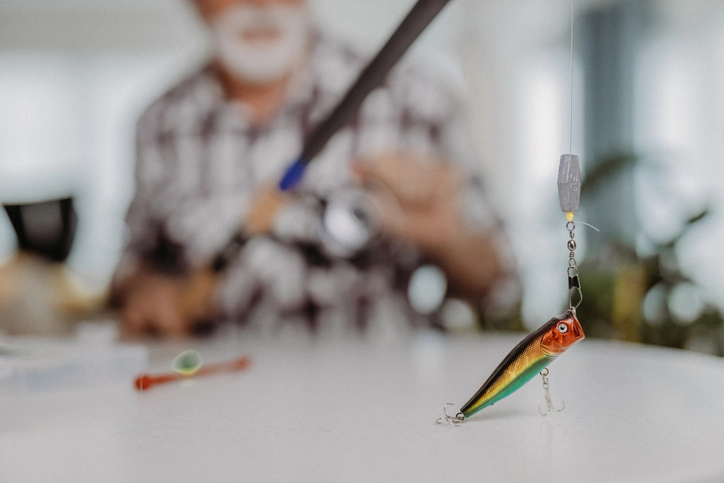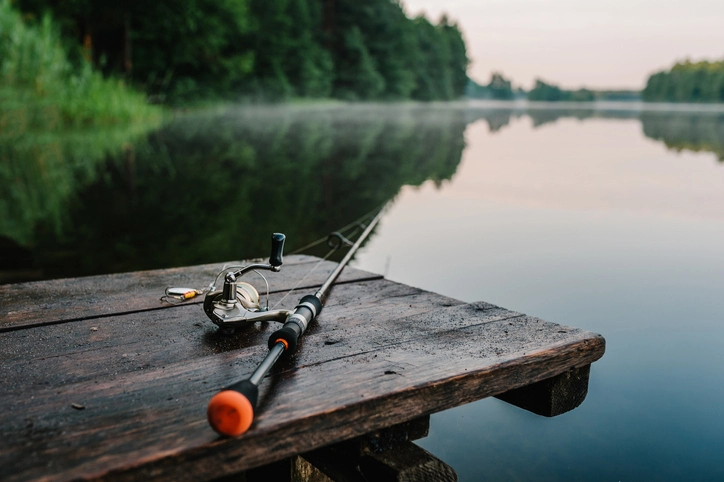How to Tie the Perfect Fishing Knot: A Step-by-Step Guide
Welcome to the quintessential guide for every angler. Mastering the art of tying the perfect fishing knot is crucial, whether you’re a beginner or a seasoned fisherman. In this guide, we’ll provide clear, step-by-step instructions to help you learn a variety of knots for different fishing situations. Ready your gear, and let’s embark on the journey to flawless knot-tying!
Are you passionate about fishing? If the answer is yes, then you understand the crucial role of having a well-tied hook. Without a correctly tied hook, your chances of catching fish are significantly reduced.
In this blog post, we will guide you through a few simple steps to effectively tie a hook onto your fishing line. We aim to make the entire process seamless for you. Take the initiative today to kickstart your journey towards becoming a proficient fisherman!
WHAT IS A FISHING KNOT, AND WHY IS IT IMPORTANT TO MASTER THE ART OF TYING ONE?
A fishing knot represents a specialized knot designed to secure a fishing line to a hook, lure, or swivel. Numerous fishing knots, like the improved Clinch, Palomar, loop, Uni, and Berkley Braid, offer distinct pros and cons. Choosing the right knot is vital for your fishing needs. A key determining factor is the ease with which the knot can be tied. For novice anglers, opting for a knot that is relatively straightforward to tie is highly recommended.
Knowing how to tie a fishing knot is essential for several reasons. Firstly, it serves as a valuable skill during boat outings, enabling the secure fastening of lines to prevent fish from escaping. Moreover, knots play a crucial role in crafting lures and bait rigs, as well as securing gear and equipment. While certain knots may be intricate, mastering a few fundamental ones empowers you to handle diverse situations with ease.
CHARACTERISTICS OF FISHING KNOTS
Crafted for monofilament or braided lines, fishing knots ensure smooth passage through rod eyes and rings. Emphasizing reliability over untangling, these knots prioritize compactness for economical fishing lines. Numerous fishing knots utilize tightly wound turns to enhance their strength. Under load, the structure of these knots undergoes a transformation, with outer wraps being drawn into the knot, causing the inner line to become outer wraps.
- The Improved Clinch Knot
stands out as a widely favored and dependable method for securely attaching fishing line to a hook or lure. The following are the steps to execute an Improved Clinch Knot:
- Thread the Line: Begin by passing the free end of the line through the eye of the hook.
- Wrap the Tag End: Take the free end and wrap it around the standing line, making 5-7 turns while moving away from the hook.
- Pass Through the Loop: Insert the free end through the loop formed just above the eye of the hook.
- Back Through the Loop: Bring the free end back through the larger loop formed, creating a smaller loop.
- Moisten and Tighten: To reduce friction, moisten the knot with saliva or water. Hold the tag end and standing line, then pull the tag end to tighten the knot.
- Trim Excess: Use scissors or clippers to trim the tag end close to the knot.
Remember to practice the knot several times to become proficient with the process, and always assess the knot’s strength and security before casting your line.
- The Palomar Knot
The Palomar knot provides a straightforward yet efficient method for attaching a hook to a fishing line. Widely employed by anglers pursuing sizable fish, it stands out as the most robust fishing knot, resistant to breakage. Here’s how to tie the Palomar knot:
- Start by threading the line through the eye of the hook.
- Create an overhand loop behind the hook and pull the line through this loop.
- Moisten the line and pull it tight, ensuring that the coils snugly encircle the eye of the hook.
- Trim any excess line, and your knot is complete.
This knot is particularly favored for its strength and durability, making it a reliable choice for anglers targeting larger fish.
- The Uni Knot
The Uni knot stands out as a versatile option for fastening a hook to your fishing line. Known for its strength and simplicity, it proves to be an excellent choice for both novice and experienced anglers. Follow these steps to tie the Uni knot:
- Initiate by passing the fishing line through the eye of the hook.
- Proceed to tie an overhand knot around the standing portion of the line.
- Utilize the overhand knot as a guide, threading the loose end of the line through the loop created by the overhand knot.
- Pull on both ends of the line until the loop snugly encircles the eye of the hook.
- To complete the process, trim any excess line.
This knot’s combination of strength and ease of tying makes it a reliable selection, suitable for anglers of all skill levels.
- Loop Knot
For anglers seeking increased flexibility in their fishing approach, the loop knot proves to be a valuable skill. This knot facilitates unrestricted movement of the bait, enhancing the likelihood of a fish successfully taking it. Follow these steps to tie the loop knot:
- Pass your line through the eye of the hook twice, forming two loops.
- Tie an overhand knot, ensuring both lines are secured tightly within the loops.
- Pull on both ends of the line until the knot is firmly in place.
- Complete the process by trimming any excess line.
This knot’s utility lies in its ability to provide freedom of movement for the bait, potentially increasing your chances of a successful catch.
- BLOOD KNOT
To seamlessly join two sections of line together using a Blood Knot, follow these steps:
Align the ends of each line for several inches, and proceed to wrap the first line around the second, making at least five turns.
Similarly, wrap the second line around the first, completing a minimum of five turns. Bring both loose ends back to the middle between the two lines.
Tighten the knot by pulling firmly on each line until it is snug and secure.
- DOUBLE SURGEON’S LOOP
A SIMPLE AND STRONG KNOT FOR CREATING LOOPS
- The Double Surgeon’s Loop serves as a straightforward and robust knot designed to fashion a loop at the end of a line. Follow these steps to tie a Double Surgeon’s Loop:
- Create a Double Line: Begin by doubling the line, folding it to create a loop while leaving sufficient tag end for the desired loop size.
- Tie a Simple Overhand Knot: Form a basic loop by tying a simple overhand knot with the doubled line.
- Pass Through the Loop Again: Thread the loop through the overhand knot once more.
- Moisten and Tighten: Reduce friction by moistening the knot with saliva or water, then pull both ends of the line to tighten the knot securely.
- Trim Excess: Achieve a tidy and secure Double Surgeon’s Loop by trimming the tag end close to the knot.
This knot is commonly utilized for establishing loops in the leader or tippet, especially for attaching flies or other terminal tackle. Practice tying it a few times to gain proficiency, and always assess the knot’s strength before putting it into use.
- CONNECTING WIRE LINE TO MONO WITH A KNOT
To effectively join wire line to monofilament, follow these steps for a seamless knot:
- Create a Bend in the Wire Line: Fold back four inches of the wire line over itself, forming a bend at the line’s end.
- Thread Monofilament Through the Bend: Pass your monofilament line through the middle of the bend, wrapping it once around the bottom of the bend.
- Wrap Monofilament Around Both Lines: Utilizing the monofilament, execute seven close turns around both the wire and monofilament lines.
- Secure the Knot. Pass the loose end of the monofilament above the center strand of monofilament and below the wire line, then pull snug for a secure connection.
- HOOK SNELLING: A STEP-BY-STEP GUIDE
For effectively snelling a hook, follow these active steps:
- Create a Loop Around the Hook’s Eye: Pass the end of the line through the eye of the hook twice, producing a loop that hangs parallel to the hook.
- Wrap the Loop Around the Hook: Form tight coils by wrapping the loop around the hook 5 to 10 times.
- Secure the Loop Under the Coils: With one finger, hold the coils in place and pull the line upward until the loop is snugly secured beneath the coils.
SUMMARY
Reel Coquina aspires that this guide has assisted you in acquiring the skill of tying a hook on a fishing line, guaranteeing the secure placement of your bait. Devote time to practicing knot tying, enabling you to execute it swiftly and effortlessly during your water outings. Should you encounter difficulty in tying a robust knot, opt for the most suitable knot for the specific situation and ensure it is pulled taut before securing it. Regular care ensures prolonged durability and enhanced performance of your fishing hooks. Thank you for reading! I trust this guide has proven beneficial!
When selecting a fishing knot, anglers should consider the target fish species, fish size, and the type of fishing line. For instance, the Palomar knot stands out as an excellent choice for heavier lines due to its strength and ease of tying. The Clinch knot, on the other hand, offers versatility and is compatible with various line types.
Emphasizing the importance of properly tightening the knot is crucial to prevent it from coming undone while the fish is in motion. An incorrectly tied knot poses the risk of unraveling, potentially leading to the escape of the catch. By choosing the appropriate knot for the situation, anglers significantly enhance their chances of success during their water adventures.


